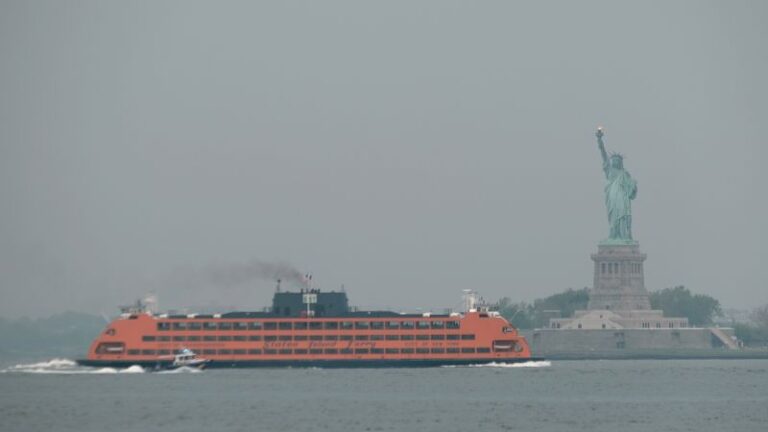CNN
—
New York topped the list for the world's worst air pollution for parts of Tuesday noxious smoke billowed south of more than a hundred fires in Quebec.
Smoke from Canada's wildfires has periodically engulfed the Northeast and mid-Atlantic more than a weekraising concerns about the harms of persistent poor air quality.
New York's air quality index was over 200 at one point Tuesday night — a level that is “very unhealthy,” according to IQair. The city had the worst air quality of any major metropolitan area on Tuesday at 10 p.m. ET, according to IQair.
Later Tuesday night, New York City had the second-worst air pollution levels in the world after New Delhi, India, IQair reported. Other cities on the list included Doha, Qatar; Baghdad, Iraq? and Lahore, Pakistan.
New York also briefly topped the list on Tuesday morning.
As a result, at least 10 school districts in upstate New York canceled outdoor activities and events on Tuesday. Those activities include academic, athletic and extracurricular events, while outdoor classes and gym classes were also canceled, school district announcements said.
Forest fire smoke contains very tiny particles, or PM2.5 – the tiniest pollutant but also the most dangerous. When inhaled, it can travel deep into lung tissue and enter the bloodstream. It comes from sources such as burning fossil fuels, dust storms and wildfires and has been linked to a number of health problems including asthma, heart disease and others respiratory diseases.
Millions of people die every year from health problems related to air pollution. In 2016, approx 4.2 million premature deaths were associated with fine particles, according to the World Health Organization.
On Tuesday, the concentration of PM2.5 in New York's air was more than 10 times the guideline set by the World Health Organization.
“If you can see or smell smoke, know you're exposed,” said William Barrett, the national senior director for clean air advocacy at the American Lung Association. “And it's important to do what you can to stay indoors during these high pollution episodes, and it's really important to monitor your health or any development of symptoms.”
Barrett said people who are especially vulnerable to wildfire smoke “are children, the elderly, pregnant women or people with respiratory or cardiovascular conditions,” whose symptoms may worsen or develop newly when exposed to the smoke.
“Really, make sure you take the appropriate steps to contact your health care providers about any symptoms that occur during these events,” Barrett said.
There are more than 150 active fires burning in Quebec this week, according to the Canadian Interagency Forest Fire Center – more than double the number of fires burning in any other Canadian province.
More than 400 fires have ignited across Quebec so far in 2023, double the average for this time of year. Nearly 9 million acres have been charred by wildfires in Canada so far this year, with nearly half a million acres burned in Quebec alone.
Air quality warnings were in effect for parts of the Northeast and Midwest on Tuesday as smoke from wildfires spread west to Detroit and Chicago.
“Weather conditions are such that widespread levels of ozone and or particulate matter are expected to be above the unhealthy for sensitive air quality index category,” the National Weather Service in Chicago said. “Active children and adults, especially those with lung or respiratory disease such as asthma, should limit prolonged outdoor activity.”
Spencer Platt/Getty Images
People walk through a Brooklyn park in New York on Tuesday morning. Air pollution levels were unhealthy for sensitive groups due to smoke from Canada's wildfires.
Detroit was listed among IQair's 10 worst locations for air pollution Tuesday afternoon. Air quality in Chicago was moderate Tuesday afternoon and is expected to remain moderate for the next two days.
Meanwhile, air quality in Pittsburgh was at unhealthy levels, with forecasts showing a slight shift to unhealthy levels for sensitive groups – such as the elderly, young children and those with respiratory problems – on Tuesday before returning to moderate levels on Wednesday. The city was on air quality alert throughout Tuesday.
Parts of New York and New England it also remained below air quality alert on Tuesday, including most of New York state and all of Massachusetts, Connecticut, Rhode Island and Vermont. Cities including Baltimore, Boston, Hartford, Providence and Montpelier, Vermont, are forecast to have air quality that is unhealthy for sensitive groups on Tuesday.
A cold front is expected to move south over the next few days, pushing smoke further south and east throughout the week.
Human-caused climate change has exacerbated the hot and dry conditions which allow fires to ignite and grow. Scientists recently reported that millions of acres burned by wildfires in the western US and Canada – an area about the size of South Carolina – could be traced to carbon pollution from the world's largest fossil fuel and cement companies.
And when they burn, the smoke can travel thousands of miles downstream, putting millions more people at risk.
“Fires are very much a global warming issue,” said Glory Dolphin Hammes, CEO of IQAir North America. he previously told CNN. “It has a lot to do with climate change, which is actually creating dangerous conditions.”



